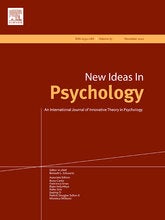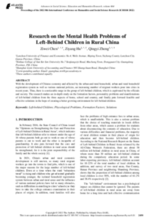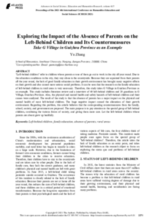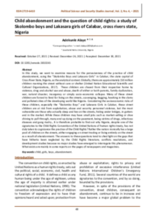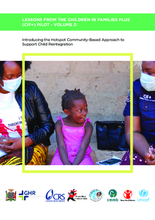Displaying 41 - 50 of 501
There exists a gap in care leaving literature about the extent to which the labelling and stereotyping of care leavers during their time in residential care facilities affects their transitions into adulthood. This paper presents an analysis of interviews conducted with care leavers from six childcare facilities in Zimbabwe (n = 30).
This sixteenth issue of the South African Child Gauge focuses attention on child and adolescent mental health and how early experiences of adversity ripple out across the life course and generations at great cost to individuals and society. It calls on South African society to put children at the centre of all policies in order to protect children from harm, build their capacity to cope with stress and adversity, and provide them with opportunities to thrive.
This study analyzes the influence of school, family and society on the psychological development of left-behind children in China from the perspective of the factors that affect their psychological problems.
This session on the central role of social protection in tackling child labour took place as part of the 5th Global Conference on Child Labour in Durban, South Africa, on May 18, 2022.
Young Australians exiting Out-of-Home Care (OOHC) face some of the most challenging access to justice issues due to experiences of trauma, increased interactions with the justice system, distrust of government services, high rates of socioeconomic disadvantage and a lack of accessible support services. This article outlines the experience of the Mid North Coast Legal Centre (MNCLC) which, through the LevelUP Project, aimed to bridge this access to justice gap with a shake-up of the traditional legal services model. Through this experience, MNCLC offers some suggestions for legal centres seeking to improve access to justice for this disadvantaged group.
"Left-behind children" refer to children whose parents or one of them go out to work in the city all year round. Due to the education conditions in the city, they stay alone in the countryside. Because they are separated from their parents all the year round, the lack of good family education in their growth environment has brought many negative effects on their growth and also caused more serious social problems. It can be seen that the research on the family education of left-behind children in rural areas is very necessary. Therefore, this study takes G Village in Guizhou Province as an example. This study includes literature review and a interview of 40 left-behind children and 20 guardians in G Village, Guizhou Province. Also, the physical and mental health and safety hazards of left-behind children and their causes were analyzed.
This study examined the reasons for the pervasiveness of the practice of child abandonment, using the “Skolombo Boys and Lakasara Girls’’ in Calabar, the state capital of Cross River State, Nigeria, as the analytical context.
The CIF+ pilot is a collaborative, locally led, intensive effort with the main aim to reintegrate 200 children from Child Care Facilities (CCFs) in Lusaka district, into families over a period of three years (2019-2021).
To complement the CIF partner interventions targeting the child and family and to enhance the sustainability of reintegration efforts, the project is using a Hotspot approach to address community-level, environmental factors that may contribute to a child’s increased risk of family separation. The collective application of the Hotspot approach is completely innovative in the Zambian child care reform space. In this brief, we spotlight the Hotspot approach and promising observations to date in undertaking this strategy.
Adolescents living in residential youth care (RYC) are at risk for disadvantaged social relationships, which in turn present a risk factor for increased loneliness. Social relationships of Slovenian adolescents aged 15–18 years and living in RYC group homes or in their primary families were investigated by relying on the social convoy framework.

